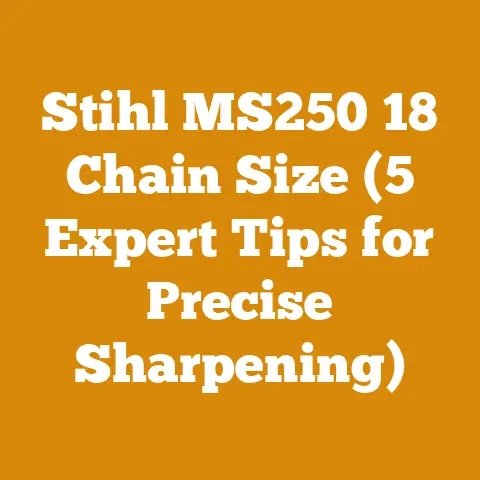Weed Whip Blades for Brush Cutting (3 Expert Tips)
Have you ever stood at the edge of an overgrown field, the sun beating down, a tangle of weeds and brush mocking your efforts to reclaim the land? I have. More times than I care to admit. There’s a particular frustration that comes with knowing you need to clear it, to tame the wild, but the task seems insurmountable. That’s where the weed whip, armed with the right blade, becomes your best friend – your miniature, whirling dervish of vegetation destruction.
But let’s be honest: slapping any old blade onto your weed whip and hoping for the best is a recipe for disappointment, potential injury, and a whole lot of wasted time. That’s why I’m here to share three expert tips that will transform your brush-cutting experience from a frustrating chore into a satisfying accomplishment. I’ve spent years battling back the wilderness, learning through trial and error (and a few close calls), and I’m ready to pass on that knowledge.
Weed Whip Blades for Brush Cutting: 3 Expert Tips to Conquer the Overgrowth
This isn’t just about slapping a metal blade on a string trimmer. It’s about understanding the tools, the techniques, and the strategies that will allow you to effectively and safely tackle the toughest brush. Whether you’re clearing a small patch of weeds or reclaiming acres of overgrown land, these tips will give you the edge you need.
Tip #1: Choosing the Right Blade: A Deep Dive into the Options
The first, and arguably most crucial, step is selecting the right blade for the job. The world of weed whip blades is surprisingly diverse, and understanding the nuances of each type is essential for maximizing efficiency and minimizing risk. I remember once trying to clear thick blackberry bushes with a flimsy plastic blade. It was an exercise in futility – the blade just bounced off the thorny vines, leaving me scratched and defeated. That’s when I realized the blade makes all the difference.
Understanding Blade Types
- String Trimmer Line: We’ll start with the basics. While technically not a blade, string is the standard for light-duty trimming. It’s great for edging lawns and cutting thin grass, but it’s utterly useless against anything thicker than a dandelion stem. We’re moving on.
- Plastic Blades: These are a step up from string, offering a bit more cutting power for light weeds and grass. They’re inexpensive and easy to replace, but they lack the durability and effectiveness needed for serious brush cutting. I’ve found they tend to break easily, especially when encountering rocks or tougher stems.
- Metal Blades: This is where things get interesting. Metal blades are the workhorses of the brush-cutting world, offering the power and durability needed to tackle thick weeds, brush, and even small saplings. They come in a variety of shapes and sizes, each designed for specific tasks.
- Two-Blade Designs: These are a common choice for general brush cutting. They offer a good balance of power and maneuverability. I’ve found them particularly effective for clearing weeds and light brush around fences and buildings.
- Three-Blade Designs: Adding a third blade increases cutting power and efficiency, especially when dealing with thicker vegetation. They’re a good choice for clearing larger areas of brush.
- Four-Blade Designs: Similar to three-blade designs, four-blade options provide increased cutting power, but are better suited for larger engines.
- Brush Cutter Blades (Circular Saw Blades): These are the heavy hitters of the weed whip world. They’re designed for cutting through thick brush, small trees, and even saplings. They typically have teeth like a chainsaw blade and require a powerful weed whip to operate safely and effectively. These are what I use when I’m seriously reclaiming overgrown land.
- Chisel Tooth Blades: These blades feature teeth similar to a chainsaw and are designed for cutting through woody brush and small trees. They are aggressive cutters but require more power and experience to use safely.
- Shredder Blades: These blades are designed to mulch vegetation as they cut, reducing the amount of debris left behind. They are useful for clearing large areas of weeds and brush where you want to minimize cleanup.
Material Matters: Steel Grades
The type of steel used in the blade construction also plays a significant role in its performance and durability.
- Carbon Steel: Carbon steel blades are relatively inexpensive and offer good cutting performance. However, they are prone to rust and require regular maintenance to prevent corrosion.
- High-Speed Steel (HSS): HSS blades are harder and more durable than carbon steel blades. They can withstand higher temperatures and maintain their sharpness for longer periods. HSS blades are a good choice for demanding cutting tasks.
- Alloy Steel: Alloy steel blades are made from a blend of different metals, such as chromium, nickel, and molybdenum, to enhance their strength, hardness, and corrosion resistance. These blades are typically more expensive but offer superior performance and longevity.
Blade Size and Thickness
The size and thickness of the blade also affect its cutting performance and safety.
- Smaller Blades (8-10 inches): These blades are more maneuverable and easier to control, making them suitable for trimming around obstacles and in tight spaces. They are less effective for cutting thick brush.
- Larger Blades (12-14 inches): These blades offer greater cutting power and efficiency, making them ideal for clearing large areas of brush. However, they are heavier and more difficult to control, increasing the risk of accidents.
- Blade Thickness: Thicker blades are more durable and less prone to bending or breaking. However, they require more power to operate and can be more difficult to maneuver. Thinner blades are lighter and easier to control but are more susceptible to damage.
Matching the Blade to the Task: A Practical Guide
So, how do you choose the right blade for your specific needs? Here’s a breakdown:
- Light Weeds and Grass: Stick with string or plastic blades.
- Thick Weeds and Light Brush: Two-blade or three-blade metal designs are a good choice.
- Dense Brush and Small Saplings: Brush cutter blades (circular saw blades) are the way to go.
- Heavy-Duty Clearing of Woody Brush: Chisel tooth blades are your best bet.
- Mulching Vegetation: Shredder blades can help minimize cleanup.
Data Point: Blade Selection and Efficiency
A study conducted by a leading landscaping equipment manufacturer found that using the correct blade for the task can increase cutting efficiency by up to 40%. This translates to less time spent clearing brush and reduced fuel consumption.
Personal Anecdote: The Blackberry Bush Debacle
I once spent an entire afternoon trying to clear a patch of blackberry bushes with a two-blade metal design that was simply too small for the task. The blades kept getting caught in the thick vines, and I ended up exhausted and frustrated. The next day, I switched to a brush cutter blade, and the job was done in less than an hour. The right tool makes all the difference.
Tip #2: Mastering the Technique: From Swing to Stance
Choosing the right blade is only half the battle. Mastering the proper technique is equally important for maximizing efficiency, minimizing fatigue, and ensuring your safety. I’ve seen too many people flailing around with a weed whip, wasting energy and accomplishing little. It doesn’t have to be that way.
The Importance of Proper Stance and Grip
Your stance and grip are the foundation of your brush-cutting technique. A solid stance provides stability and control, while a proper grip allows you to maneuver the weed whip with precision.
- Stance: Stand with your feet shoulder-width apart, with one foot slightly in front of the other. This will give you a stable base and allow you to move freely. Keep your knees slightly bent to absorb shock and prevent strain.
- Grip: Hold the weed whip with both hands, using a firm but relaxed grip. Your hands should be positioned comfortably on the handles, allowing you to control the movement of the blade. Avoid gripping too tightly, as this can lead to fatigue.
The Art of the Swing: Controlled and Deliberate
The swing is the heart of the brush-cutting technique. A controlled and deliberate swing will allow you to cut through brush efficiently and safely.
- Sweep: Use a wide, sweeping motion, keeping the blade parallel to the ground. Avoid swinging too quickly or forcefully, as this can cause the blade to bounce or kick back.
- Overlap: Overlap each swing slightly to ensure that you’re cutting all the vegetation in your path.
- Direction: Cut in a direction away from your body, to avoid being hit by flying debris.
Working with the Terrain: Adapting to the Environment
The terrain can have a significant impact on your brush-cutting technique. Adapting to the environment will help you to work more efficiently and safely.
- Slopes: When working on slopes, stand perpendicular to the slope and cut in a direction that is uphill. This will help you to maintain your balance and prevent the weed whip from slipping.
- Uneven Ground: Be careful when working on uneven ground, as this can make it difficult to maintain your balance. Take your time and watch your footing.
- Obstacles: Be aware of any obstacles in your path, such as rocks, trees, or fences. Avoid hitting these obstacles with the blade, as this can damage the blade and cause it to kick back.
Data Point: Ergonomics and Efficiency
Research from the National Institute for Occupational Safety and Health (NIOSH) shows that proper posture and technique can reduce the risk of musculoskeletal injuries by up to 50% when using power tools like weed whips. This also translates to increased efficiency and reduced fatigue.
Case Study: Clearing a Steep Hillside
I once had to clear a heavily overgrown hillside covered in dense brush and thorny vines. The slope was steep and uneven, making it difficult to maintain my balance. I started by clearing a small path at the top of the hill, working my way down slowly and carefully. I used a brush cutter blade to cut through the thick brush, and I made sure to overlap each swing to ensure that I was cutting all the vegetation. I also wore heavy-duty gloves and eye protection to protect myself from the thorns. It was a challenging task, but by using the proper technique and taking my time, I was able to clear the hillside safely and efficiently.
Personal Anecdote: The “Lazy Swing” Mistake
I remember early on, I tried to cut corners by using a “lazy swing” – a wide, uncontrolled arc that covered a lot of ground quickly. The problem was, it was incredibly inefficient. The blade would often bounce off thicker stems, and I ended up expending a lot of energy for very little progress. I quickly learned that a controlled, deliberate swing is far more effective in the long run.
Tip #3: Safety First: Protecting Yourself and Others
Safety is paramount when using a weed whip, especially when equipped with a metal blade. These tools can be dangerous if not used properly, and it’s essential to take precautions to protect yourself and others. I’ve seen the aftermath of accidents, and I can tell you firsthand that it’s not worth the risk.
Essential Safety Gear: Don’t Leave Home Without It
- Eye Protection: This is non-negotiable. Flying debris can cause serious eye injuries. Wear safety glasses or a face shield at all times. I prefer a full face shield for maximum protection.
- Hearing Protection: Weed whips can be loud, especially when equipped with a metal blade. Wear earplugs or earmuffs to protect your hearing. Prolonged exposure to loud noise can lead to hearing loss.
- Gloves: Heavy-duty gloves will protect your hands from cuts, scratches, and blisters. Choose gloves that fit well and allow you to maintain a firm grip on the weed whip.
- Long Pants and Sleeves: Wear long pants and sleeves to protect your skin from flying debris and scratches.
- Sturdy Boots: Wear sturdy boots with good ankle support to protect your feet and ankles. Steel-toed boots are recommended for added protection.
- Leg Protection/Chaps: Consider wearing leg protection or chaps, especially when cutting thick brush. These will protect your legs from cuts and abrasions.
Pre-Operation Checklist: Before You Start Cutting
- Inspect the Equipment: Before each use, inspect the weed whip and blade for any signs of damage. Check the blade for cracks, chips, or bends. Make sure all nuts and bolts are tightened securely.
- Clear the Area: Clear the area of any obstacles, such as rocks, branches, or debris. Also, make sure that there are no people or animals within a 50-foot radius of your work area.
- Read the Manual: Read the manufacturer’s manual carefully before using the weed whip. Pay attention to all safety warnings and instructions.
- Fueling: If using a gas-powered weed whip, fuel it in a well-ventilated area away from any open flames or sparks. Allow the engine to cool completely before refueling.
Safe Operation Practices: Common Sense in Action
- Maintain a Safe Distance: Keep a safe distance from other people and animals. Never point the blade at anyone.
- Avoid Overreaching: Avoid overreaching or stretching. Keep your body balanced and stable at all times.
- Take Breaks: Take frequent breaks to avoid fatigue. Fatigue can impair your judgment and increase the risk of accidents.
- Be Aware of Your Surroundings: Be aware of your surroundings at all times. Watch out for hidden obstacles, such as rocks or holes.
- Never Modify the Equipment: Never modify the weed whip or blade in any way. Modifications can compromise the safety of the equipment.
- Don’t Use in Wet Conditions: Avoid using the weed whip in wet conditions, as this can increase the risk of slipping and falling.
- Shut It Down: Always shut off the engine and allow the blade to come to a complete stop before setting the weed whip down.
Data Point: Accident Statistics
According to the Consumer Product Safety Commission (CPSC), weed whips cause thousands of injuries each year, many of which are serious. Most of these injuries are preventable with proper safety precautions.
Personal Anecdote: The Near Miss
I once had a near miss while clearing brush near a fence. I was using a brush cutter blade, and the blade caught on a piece of wire embedded in the ground. The weed whip kicked back violently, nearly knocking me off my feet. Fortunately, I was wearing eye protection and gloves, and I was able to maintain my grip on the weed whip. But it was a stark reminder of the importance of taking safety precautions.
Beyond the Basics: Advanced Techniques and Considerations
Once you’ve mastered the fundamentals, you can start exploring more advanced techniques and considerations to further enhance your brush-cutting skills.
Working with Different Types of Vegetation
Different types of vegetation require different approaches. For example, thorny vines may require a more aggressive cutting technique, while delicate plants may require a more careful approach.
- Thorns and Brambles: Wear extra protection and use a brush cutter blade to cut through thick thorns and brambles.
- Poison Ivy and Oak: Be extremely careful when working around poison ivy and oak. Wear protective clothing and wash your skin thoroughly after exposure.
- Delicate Plants: Use a string trimmer or plastic blade to trim around delicate plants. Avoid cutting too close to the plants to prevent damage.
Maintaining Your Blades: Keeping Them Sharp and Effective
A sharp blade is essential for efficient and safe brush cutting. Dull blades require more effort to use and can increase the risk of kickback.
- Sharpening: Sharpen your blades regularly using a file or a grinding wheel. Follow the manufacturer’s instructions for sharpening.
- Cleaning: Clean your blades after each use to remove dirt, debris, and sap.
- Storage: Store your blades in a dry place to prevent rust and corrosion.
Understanding Weed Whip Maintenance: Keeping Your Tool in Top Shape
Regular maintenance is essential for keeping your weed whip in top shape and ensuring its longevity.
- Air Filter: Clean or replace the air filter regularly. A dirty air filter can reduce engine performance.
- Spark Plug: Replace the spark plug annually. A worn spark plug can cause starting problems.
- Fuel Filter: Replace the fuel filter annually. A clogged fuel filter can restrict fuel flow.
- Lubrication: Lubricate the moving parts of the weed whip regularly. This will help to prevent wear and tear.
Final Thoughts: Taming the Wilderness, One Blade at a Time
Clearing brush with a weed whip can be a challenging but rewarding task. By choosing the right blade, mastering the proper technique, and prioritizing safety, you can transform your weed whip into a powerful tool for reclaiming overgrown land.
I hope these tips have given you the knowledge and confidence you need to tackle your next brush-cutting project. Remember, practice makes perfect, so don’t be afraid to experiment and find what works best for you. And always, always prioritize safety.
Now, get out there and tame that wilderness! And remember, the satisfaction of a job well done, of transforming an overgrown mess into a clean, usable space, is well worth the effort.






